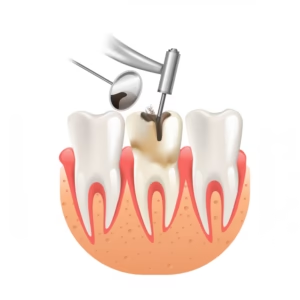

Root Canal Treatment
Root Canal Treatment, often known as RCT, has evolved into a reasonably easy and pain-free treatment that often only requires one or two visits to an endodontist, due to advancein technology and equipment.
If a Root Canal Treatment (RCT) is indicated, you should expect a step-by-step guidance.
Why is RCT required/reasons for Root Canal Therapy
• Recurrentor repeated abscess on gums
• Prolonged sensitivity
• Severe pain radiation from jaw to ear and head
• Dull pain on chewing
• Darkening of tooth
• Deep decay on the tooth
• Difficulty or pain while chewing food
• Cracked or broken tooth
How is Root Canal performed?
STEP 1 – Anesthesia is administered to numb the tooth and surrounding gums. You might feel a pinch when the needle is injected for a moment. When the tooth is numb, a small sheet of dental dam is placed to keep the tooth dry during the procedure.
STEP 2 – An opening is made on the crown of the tooth either with a dentist drill or hard tissue laser. Once the opening is made, the damaged nerve inside the tooth is removed with the help of an antimicrobial solution or laserto eliminate and reduce the risk of further infection.
STEP 3 – Once the complete roots are dried and cleaned, the endodontist will fill it with a rubber like material called gutta-percha and seal it with a permanent filling.
STEP 4 – After few weeks, the dentist finishes the treatment by placing a permanent crown (metal free or metal ceramic) or a similar type of filling. Depending upon the condition of natural tooth a small supporting post or a screw can be placed inside the root chamber to make crown more stable.
How is Root Canal performed?
STEP 1 – Anesthesia is administered to numb the tooth and surrounding gums. You might feel a pinch when the needle is injected for a moment. When the tooth is numb, a small sheet of dental dam is placed to keep the tooth dry during the procedure.
STEP 2 – An opening is made on the crown of the tooth either with a dentist drill or hard tissue laser. Once the opening is made, the damaged nerve inside the tooth is removed with the help of an antimicrobial solution or laserto eliminate and reduce the risk of further infection.
STEP 3 – Once the complete roots are dried and cleaned, the endodontist will fill it with a rubber like material called gutta-percha and seal it with a permanent filling.
STEP 4 – After few weeks, the dentist finishes the treatment by placing a permanent crown (metal free or metal ceramic) or a similar type of filling. Depending upon the condition of natural tooth a small supporting post or a screw can be placed inside the root chamber to make crown more stable.
Root Canal Treatment after care
•Brush regularly twice a day, once in the morning after you wake up and at night before going to bed.
•Use warm water and salt rinses as a regular procedure for a week to reduce the discomfort on the treated area.
•Keep the root canal treated tooth or teeth clean. Follow-up visits are important.
•Use of powered toothbrush and water flosser is recommended.
•Your dentist will prescribe over the counter medications for a few days in case you have any symptoms.
